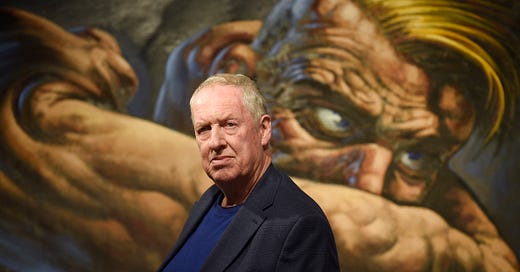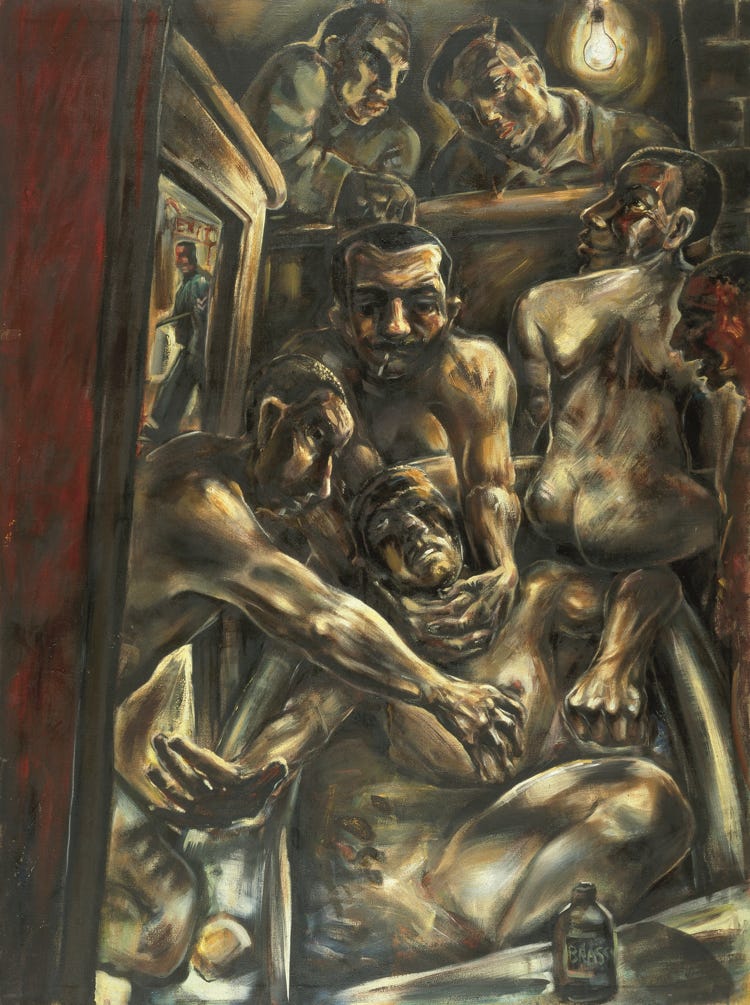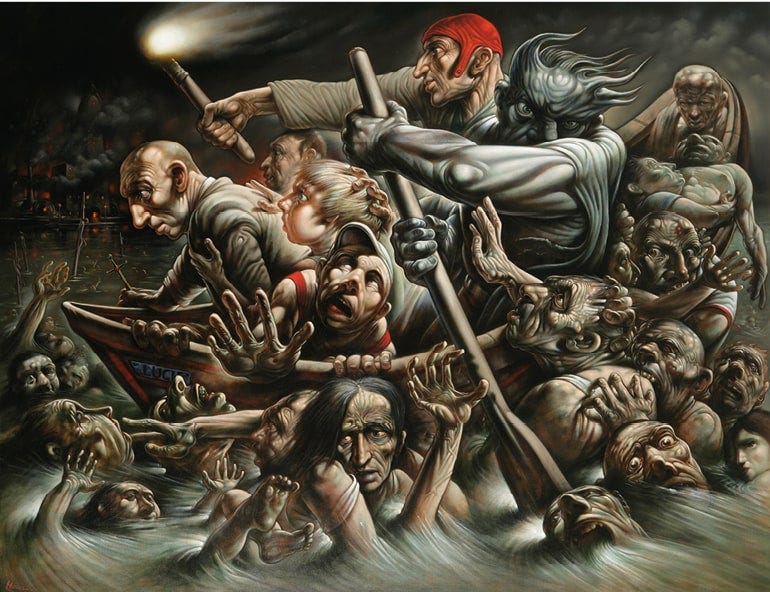Exhibition Review: Peter Howson | When The Apple Ripens - A Retrospective
City Arts Centre, Edinburgh ⭐️⭐️⭐️⭐️⭐️
Up close and personal with one of Peter Howson’s nightmarish masterpieces there’s an instinctive urge to touch, to run a finger over the heavy ridges of paint and engage physically with the work. The hope? That momentarily at least, you might transcend into Howson’s world, a place where a fragile glimmer of hope seeps through the despair. Of course, it’s an urge to be rejected.
When The Apple Ripens is, as the title declares, A Retrospective, one that marks Howson’s 65th birthday and brings together, over three floors, a selection of his works in various disciplines, including oil on canvas and ink on paper.
Coming to prominence in the 1980s, all periods of Howson’s work are represented, from his early paintings of the tramps and boxers, hard-men and hooligans he became known for, to the human desolation captured during his time as a war artist in Bosnia (a side gallery dedicated to that time comes with a trigger warning and it is sobering place to reflect on the human face of conflict) and the hope brought by his religious conversion.
There’s a savagery in almost all Howson’s work, a menace in the eyes of his protagonists and a yearning, either for understanding or release.
Even Football (1997), the piece that welcomes you, boasts a sense of toxic masculinity, despite being lighter than many of the images which follow.
Imposing canvases such as The Heroic Dosser (1987) capture Howson’s skill at capturing those on the edges of society, revealing their pride while exposing their hopelessness as they morph into ugly caricatures of the life they inhabit.
Contrastingly, in the likes of Blind Leading the Blind I - Mother & Daughter (1991), though the grotesque nature of his figures remains, it’s softened in style to become almost seaside-postcard like.
Born in 1958 in West London, Howson moved with his parents to Prestwick at the age of four. Bullied at school and having witnessed others being abused during his time in the Army, Howson has since acknowledged that the ‘seam of violence’ that runs throughout his work can be traced to those early experiences.
Perhaps the most striking picture to capture the genesis of the darkness he employs in his art is Regimental Bath (1985), a monstrous depiction of a barrack’s punishment in which a naked soldier is brutally degraded by two fellow members of a Scottish infantry regiment who force him into a bath filled with urine and faeces while others look on as another, naked, smiles and squats over the bath, a nearby officer turning a blind eye as he passes by.
Prominent throughout the exhibition are works from the last two decades, in which the artist has produced a wealth of religious imagery as well as ‘multifaceted apocalyptic visions’ inspired by his own personal struggles.
Treated for drug and alcohol addiction in 2000, the artist followed Alcoholics Anonymous’s 12-step programme, converting to Christianity at the same time.
Howson has described the period since that turmoil as being ‘up and down’ and it’s evident in the lost souls and mystic symbolism captured in much of his recent work, like his Stations of the Cross, while a nearby portrait of David Bowie and elsewhere, a study of Steven Berkoff are strangely incongruous.
To appreciate the breathtaking scale of Howson’s ability be sure to allow yourself time to get lost in his creations, paintings such as The Third Step (2001), a mystical mix of woe and release and a direct reference to his rehabilitation, or the equally impressive Dante-inspired Acheron (2005), which finds Howson and his daughter Lucie being rowed across the Acheron, one of the five rivers of Hades in Greek mythology, surrounded by a sea of suffering souls. Both are completely mesmerising.
Later ink on paper work is equally detailed if even more finely layered; Thursday at Eight and An Important Announcement (both 2020) are ethereal pieces, offering new detail and interpretation with each viewing.
Intentional or not, there’s an ever present homoerotic undertone in the bulked-up bodies of Howson’s working class Colossuses. Broken but seldom bowed, they may seem ‘cleaner’ in later works but still retain a visceral impact while allowing an intriguing glimpse into the mind of one of the leading figurative painters of his generation.
When the Apple Ripens is a savage and sobering walk through the lives of the disenfranchised. Walk with them at the City Arts Centre.
Until October 1, tickets https://www.edinburghmuseums.org.uk/whats-on/when-apple-ripens-peter-howson-65
Credit: Líam Rudden’s Must See Theatre









